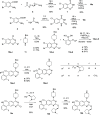Contribution of Noncovalent Recognition and Reactivity to the Optimization of Covalent Inhibitors: A Case Study on KRasG12C
- PMID: 38991015
- PMCID: PMC11334105
- DOI: 10.1021/acschembio.4c00217
Contribution of Noncovalent Recognition and Reactivity to the Optimization of Covalent Inhibitors: A Case Study on KRasG12C
Abstract
Covalent drugs might bear electrophiles to chemically modify their targets and have the potential to target previously undruggable proteins with high potency. Covalent binding of drug-size molecules includes a noncovalent recognition provided by secondary interactions and a chemical reaction leading to covalent complex formation. Optimization of their covalent mechanism of action should involve both types of interactions. Noncovalent and covalent binding steps can be characterized by an equilibrium dissociation constant (KI) and a reaction rate constant (kinact), respectively, and they are affected by both the warhead and the scaffold of the ligand. The relative contribution of these two steps was investigated on a prototypic drug target KRASG12C, an oncogenic mutant of KRAS. We used a synthetically more accessible nonchiral core derived from ARS-1620 that was equipped with four different warheads and a previously described KRAS-specific basic side chain. Combining these structural changes, we have synthesized novel covalent KRASG12C inhibitors and tested their binding and biological effect on KRASG12C by various biophysical and biochemical assays. These data allowed us to dissect the effect of scaffold and warhead on the noncovalent and covalent binding event. Our results revealed that the atropisomeric core of ARS-1620 is not indispensable for KRASG12C inhibition, the basic side chain has little effect on either binding step, and warheads affect the covalent reactivity but not the noncovalent binding. This type of analysis helps identify structural determinants of efficient covalent inhibition and may find use in the design of covalent agents.
Conflict of interest statement
The authors declare no competing financial interest.
Figures





Similar articles
-
Discovery of novel quinazoline-based covalent inhibitors of KRAS G12C with various cysteine-targeting warheads as potential anticancer agents.Bioorg Chem. 2021 May;110:104825. doi: 10.1016/j.bioorg.2021.104825. Epub 2021 Mar 13. Bioorg Chem. 2021. PMID: 33774492
-
Targeting KRAS Mutant Cancers with a Covalent G12C-Specific Inhibitor.Cell. 2018 Jan 25;172(3):578-589.e17. doi: 10.1016/j.cell.2018.01.006. Cell. 2018. PMID: 29373830
-
Proof of concept for poor inhibitor binding and efficient formation of covalent adducts of KRASG12C and ARS compounds.Org Biomol Chem. 2020 Apr 29;18(16):3069-3081. doi: 10.1039/d0ob00071j. Org Biomol Chem. 2020. PMID: 32101243
-
KRAS G12C Game of Thrones, which direct KRAS inhibitor will claim the iron throne?Cancer Treat Rev. 2020 Mar;84:101974. doi: 10.1016/j.ctrv.2020.101974. Epub 2020 Jan 23. Cancer Treat Rev. 2020. PMID: 32014824 Free PMC article. Review.
-
Structural insights into small-molecule KRAS inhibitors for targeting KRAS mutant cancers.Eur J Med Chem. 2024 Nov 5;277:116771. doi: 10.1016/j.ejmech.2024.116771. Epub 2024 Aug 15. Eur J Med Chem. 2024. PMID: 39167893 Review.
Cited by
-
Covalent-Allosteric Inhibitors: Do We Get the Best of Both Worlds?J Med Chem. 2025 Feb 27;68(4):4040-4052. doi: 10.1021/acs.jmedchem.4c02760. Epub 2025 Feb 12. J Med Chem. 2025. PMID: 39937154 Free PMC article. Review.
References
-
- Copeland R. A.Evaluation of Enzyme Inhibitors in Drug Discovery: A Guide for Medicinal Chemists and Pharmacologists, 2nd edition; John Wiley & Sons, 2013. - PubMed
Publication types
MeSH terms
Substances
LinkOut - more resources
Full Text Sources
Miscellaneous

